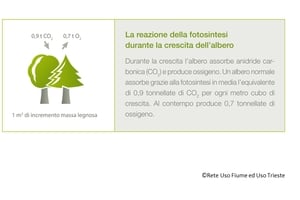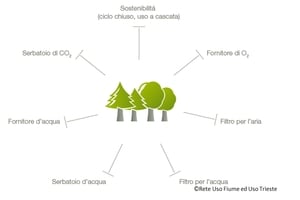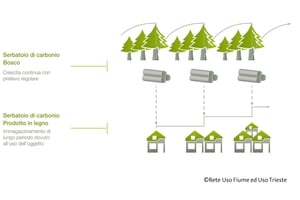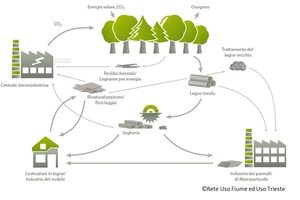
Value chain forest-wood
Wood unites us. The individual sectors exploit the synergies and create a vast network of collaboration.
The trees in the forests absorb enormous amounts of carbon dioxide during their growth. The photosynthesis process provides for a significant contribution to climate protection. In times of rising CO2 emissions, lush forests, like those found in Italy, are extremely important to our future. Many people don't realize that Italy is such a densely forested country: in fact, almost 35% of the national territory is covered by forest!
We must also consider that, within Italy's forests, only 40% of the wood mass that regrows in one year is utilized. Our woodlands are growing rapidly - over one cubic metre of wood grows in Italy every second!
All wood products - including houses, furniture and even tools for the home - store the carbon that the tree has assimilated from the atmosphere. Trees, in fact, do this job quite efficiently, accumulating 1 tonne for every cubic metre of wood produced! These amounts of carbon are removed from the atmosphere and are held as long as the wood product remains in use, and even beyond.
CO2 storage for centuries
Wood products can therefore be seen as CO2 "storage wells", tying up CO2 for centuries on end, based on the specific application. The more we use wood products to replace materials whose production processes result in CO2 emissions, the less CO2 will be emitted into the atmosphere: this is the so-called "substitution effect."
When wood products are used in place of construction materials like cement, bricks, steel and aluminium, this is referred to as material substitution. This substitution has a positive effect on CO2 emissions, because the production processes often involve the use of fossil fuels (petroleum, coal, etc.) for both production and transport purposes. Wood material, in contrast, is processed, not produced! Furthermore, wood can often be used for energy purposes at the end of its life cycle.
"Every cubic meter of wood used in place of other building materials reduces the average emissions of CO2 into the atmosphere by 1.1 tonnes. If we add this value to the 0.9 tonnes of CO2 contained within the wood itself, the use of one cubic metre of wood reduces the amount of CO2 emitted into the atmosphere by 2 tonnes.
The use of wood material thus results in the assimilation of carbon dioxide, reduced emissions and greater quantities of CO2 saved! If the wood is burned or left to decay naturally in the forest at the end of its life cycle, it releases the same amount of CO2 into the atmosphere that it had previously removed.
We must also consider that, within Italy's forests, only 40% of the wood mass that regrows in one year is utilized. Our woodlands are growing rapidly - over one cubic metre of wood grows in Italy every second!
All wood products - including houses, furniture and even tools for the home - store the carbon that the tree has assimilated from the atmosphere. Trees, in fact, do this job quite efficiently, accumulating 1 tonne for every cubic metre of wood produced! These amounts of carbon are removed from the atmosphere and are held as long as the wood product remains in use, and even beyond.
CO2 storage for centuries
Wood products can therefore be seen as CO2 "storage wells", tying up CO2 for centuries on end, based on the specific application. The more we use wood products to replace materials whose production processes result in CO2 emissions, the less CO2 will be emitted into the atmosphere: this is the so-called "substitution effect."
When wood products are used in place of construction materials like cement, bricks, steel and aluminium, this is referred to as material substitution. This substitution has a positive effect on CO2 emissions, because the production processes often involve the use of fossil fuels (petroleum, coal, etc.) for both production and transport purposes. Wood material, in contrast, is processed, not produced! Furthermore, wood can often be used for energy purposes at the end of its life cycle.
"Every cubic meter of wood used in place of other building materials reduces the average emissions of CO2 into the atmosphere by 1.1 tonnes. If we add this value to the 0.9 tonnes of CO2 contained within the wood itself, the use of one cubic metre of wood reduces the amount of CO2 emitted into the atmosphere by 2 tonnes.
The use of wood material thus results in the assimilation of carbon dioxide, reduced emissions and greater quantities of CO2 saved! If the wood is burned or left to decay naturally in the forest at the end of its life cycle, it releases the same amount of CO2 into the atmosphere that it had previously removed.
Rete Uso Fiume ed Uso Trieste
Via Macello, 57 (at Assoimprenditori)
I-39100 Bolzano
South Tyrol - Italy
Phone +39 0471 068 000
Fax +39 0471 068 150
www.traviuf.it
VAT No. IT01677580217
Via Macello, 57 (at Assoimprenditori)
I-39100 Bolzano
South Tyrol - Italy
Phone +39 0471 068 000
Fax +39 0471 068 150
www.traviuf.it
VAT No. IT01677580217





